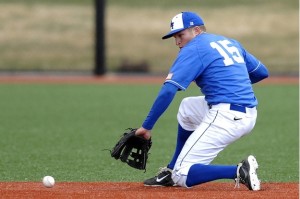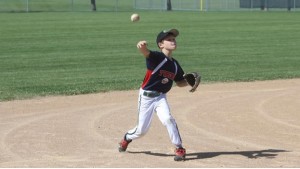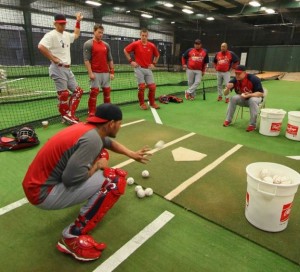5 Basic Tips for Little League Practice Drills
 The basic little league practice drills are taught with a great focus on fundamental aspects of baseball training. The most encouraging thing about baseball is that by implementing these basic practice drills into your training regime at any age will assist in creating exceptional baseball players. Practicing these basic practice drills on a regular basis will result in great learning and performance of the game of baseball.
The basic little league practice drills are taught with a great focus on fundamental aspects of baseball training. The most encouraging thing about baseball is that by implementing these basic practice drills into your training regime at any age will assist in creating exceptional baseball players. Practicing these basic practice drills on a regular basis will result in great learning and performance of the game of baseball.
It is greatly important to use baseball drills as fun games and competitions, especially with younger players, to make it highly enjoyable. Children love some good competition and will enjoy drills thoroughly if they have a fun and competitive element. Competition will also encourage players to learn the skills needed for the game to improve and ultimately win these ‘mini’ competitions.
Additionally, it is vital that you know all of the little league rules, regulations and policies, in order to be an effective little league coach. In order to be a little league coach for children, it is essential to know all of the current rules and policies. Being up to date on the latest rule will aid your coaching abilities and ensure your players become world-class little league players.
Children are unique to train, so here are some general thoughts that can help your training sessions:
- Use training stations. For effective training with children, implement stations and group the children into groups of 4 or 5 children each. This is great to reduce idle time when one child is on the pitch. Engaging the children and letting them move around from one stations to the next will ensure they have fun while training to be a great baseball player.
- Get an assistant coach. Assistant coaches play an important role in training children. It may be difficult for a coach to conduct all training drills on their own and require the help of an assistant. It is highly recommended that you appoint an assistant coach to help you train a world-class team.
Five basic tips for little league practice drills
Drill Tip 1: Fielding on the Knees
Learning to field a ground ball can be done quite automatically at a point player bends to kneel on the ground. Firstly, the kneeling position allows the player to keep their hands out in front. A common problem for children learning to play baseball, is missing the ball when trying to field it deep inside with their open feet. A player should field a ground ball using their hands and keeping them out in a front direction. This allows the player to easily keep an eye on the ball that reaches their glove.
Additionally, this drill teaches players how to read hops better, as well as when to change from the forehand and backhand positions. It is important to teach young players that a fundamental practice in baseball is to have their glove out in front.
Drill Tip 2: The Initial Position
Each player that initiates to resist should move to their right when the ball is about to hit. Both infielders and the outfielders should take an athletic posture. This is done by keeping their feet still on the ground as soon as the ball hits. This allows them to have a jumping start along with the ball.It should be something that all baseball players should learn.
This drill can be taught by allowing all your players onto the pitch while they begin to bat and fields. This can also be taught by the coach. He lifts his knee at a time when the fielder is about to ‘jump’. The coach then rolls, flips or throws the ball towards the player. Don’t forget to click here to pick your best little league baseball bat.
 Drill Tip 3: 3.1-2-Field, 3-4- Throw
Drill Tip 3: 3.1-2-Field, 3-4- Throw
The players can field and throw by going along the baseball. The 1-2 fields, 3-4 throw is the technique used here in order to complete the drill.
Coaches teach this drill by keeping the ball on a ground. Next, allow the fielder to move slowly towards the ball. Right-hand fielders can use a Right-Left- Field, Right- Left- Throw technique. This is a highly effective drill for coaching fielders and teaching them to keep staying below the ball. This enables players to take fewer steps when throwing the ball to a particular point.
 Drill tip 4: Grabbing Flying Balls
Drill tip 4: Grabbing Flying Balls
This method is usually found to be a difficult type of drill for players. While a ball is about to reach the ground it should be judged carefully by a player. This is a skill that must be learned. On sending the ball toward the player; the player tries to put it to halt. However, while the ball is still up in the air, the player may be hesitant to grab it. This is because most players fear about failing or getting hit by the ball if they miss. Rather begin this drill with a tennis ball and no gloves at the start, until your players become more confident.
After keeping the ball 5 feet far from the player, the coach should raise his or her knee to indicate that the player takes a ready position. The coach tosses the ball towards the player, who should be able to get it. Going through this drill regularly will help younger players build up their confidence in this basic baseball requirement. Once your young players have become confident enough to catch the ball in this manner, try using a baseball and glove.
 Drill Tip 5: Learn to bowl over the Balloon
Drill Tip 5: Learn to bowl over the Balloon
In order to help children learn how to throw correctly, the coach will have the player show how they understand the concept of throwing. While they are asked to throw a ball at a particular point, most children can carry out the task with ease. For this drill, a helium inflated balloon is placed on a batting tee. Next, it is used to teach children how to aim when throwing a ball.
This drill can be a very fun exercise for young children while helping them learn a new skill. As per counting system, the 1-2-throw is again used in this drill, together with the fielding drill.
During training, children are asked to step towards the target and position the front elbow or glove towards the target. It is all done before throwing the ball. Doing drill teaches, children are taught to make full use of the whole body while throwing a baseball. It is suggested to keep the elbow starting from arm whip and raising it. Make sure it is kept at a higher level from the collar bone. All this is done in order to reduce the risk of getting injured.
My name is David, I am an editor/co-founder of www.theplanetofbaseball.com. Being a software engineer by day and a baseball blogger by night, I also participated in the training activities of a youth baseball team at my hometown. I have passion with baseball, it pertains to my life from childhood until now and I love to share what is related to that passion with others. I believe in the support of other baseball bloggers like me to spread the passion.

Sports is love and we must keep it as a passion for life. This is always inspiring for me while with friends.
Doing practice is very important if anyone want to improve their game. But that is going to be possible if practice is done with right ways. This post can be very helpful in learning how to do practice in right way..
nice post…..thanks for sharing
Thanks for sharing your thoughts on baseball drills.
Regards